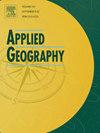另一半的生命是绿色的吗?将伊朗德黑兰的城市绿色基础设施与社会经济不平等和空间隔离联系起来
IF 4
2区 地球科学
Q1 GEOGRAPHY
引用次数: 0
摘要
城市绿色基础设施提供广泛的生态系统服务,提高整体生活质量。然而,这些利益并不总是在城市区域或不同人口群体之间平均分配。本研究利用占领状态数据和开源高分辨率卫星图像强调了分裂城市德黑兰的城市绿色基础设施不平等。研究结果表明,高收入职业群体与低收入职业群体在城市空间结构上存在明显的南北分化。居住在北部的上层职业群体受益于私人空间和公共街道边缘的高植被密度和树冠覆盖,并且更靠近城市公园,而居住在南部的底层职业群体则受到城市自然优势提供和分布不均的影响。在距离公园300米的人口普查区,底层职业群体的平均比例几乎是顶层职业群体的两倍。历史上持续的南北鸿沟和环境不公正进一步表明,几十年来,较贫穷的公民被排除在城市绿化倡议之外。因此,它们应该被重新纳入正式的城市规划议程,以帮助重建一个包容和可持续的城市。我们还强调了遥感技术和职业状况数据在研究世界各地城市环境不平等方面的潜力。本文章由计算机程序翻译,如有差异,请以英文原文为准。
Is life green on the other half? Linking urban green infrastructure to socio-economic inequality and spatial segregation in Tehran, Iran
Urban Green Infrastructure provides a wide range of ecosystem services that promote overall quality of life. However, these benefits are not always distributed equally across the urban regions or among different population groups. The present study highlights urban green infrastructure inequality in the divided city of Tehran using occupation status data and open-source high-resolution satellite imagery. Our results reveal that high-income occupation groups live separately from the bottom occupational groups in the city, with a clear north-south division reflected in the urban spatial structure. The top occupation groups residing in the north benefit from both high vegetation density and tree canopy cover in private spaces and public street verges and live closer to urban parks, whereas the bottom occupation groups in the south suffer from the uneven provision and distribution of urban nature advantages. The average proportion of bottom occupation groups in census tracts with >300 m distance from public parks is almost double that of top occupation groups. The persistent historical north-south divide and environmental injustice further indicate that, over the decades, poorer citizens have been excluded from urban greening initiatives. Therefore, they should be brought back into the formal urban planning agenda to help rebuild an inclusive and sustainable city. We also highlight the potential of remote sensing techniques and occupation status data for studying environmental inequality across cities worldwide.
求助全文
通过发布文献求助,成功后即可免费获取论文全文。
去求助
来源期刊

Applied Geography
GEOGRAPHY-
CiteScore
8.00
自引率
2.00%
发文量
134
期刊介绍:
Applied Geography is a journal devoted to the publication of research which utilizes geographic approaches (human, physical, nature-society and GIScience) to resolve human problems that have a spatial dimension. These problems may be related to the assessment, management and allocation of the world physical and/or human resources. The underlying rationale of the journal is that only through a clear understanding of the relevant societal, physical, and coupled natural-humans systems can we resolve such problems. Papers are invited on any theme involving the application of geographical theory and methodology in the resolution of human problems.
 求助内容:
求助内容: 应助结果提醒方式:
应助结果提醒方式:


